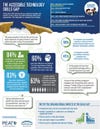Good Tech Design is Accessible, But There's a Skills Gap
Software designers and IT know the importance of a good user experience. However, accessibility by design isn't as pervasive as it should be. That will change as accessibility is integrated into more university programs.

Today's businesses are more employee-friendly than they've been historically, but they could do a better job of making technology accessible to those with special needs. When most people think about user experience (UX) design, graphics, video, colors, sounds, words and performance come to mind, but not all users benefit equally from the same types of designs.
According to the Federal Communications Commission, approximately 36 million Americans suffer from hearing loss and 25 million suffer from vision loss. Failure to integrate accessibility into UX designs negatively impacts the productivity of workers who could use the assistance. And, of course, there are compliance issues.
Most businesses lack the accessibility talent they need to meet their goals of inclusiveness, and the talent isn't easy to find. The Partnership on Employment & Accessible Technology (PEAT) and Teach Access have teamed up to change that.
PEAT and Teach Access strive to advance accessibility
PEAT fosters collaboration and action around accessibility in the workplace. Guided by a consortium of policy and technology leaders, PEAT helps employers, IT companies, and others understand why it pays to build and buy accessible technology, and how to do so. PEAT is funded by the U.S. Department of Labor's Office of Disability Employment Policy (ODEP) and is managed by the Rehabilitation Engineering and Assistive Technology Society of North America (RESNA).
[For an example of how the industry is addressing accessibilty challenges check out UI Developers Move the Needle on Accessibility.]
Teach Access is a fiscal sponsorship fund at Silicon Valley Community Foundation (SVCF) which is working with universities to include accessibility and universal design principles in curricula of computer scientists, designers and researchers in undergraduate, graduate and continuing education.
"Teach Access was a natural coming together among companies that compete a lot, but we have to deal with the fact that when we work with a designer, most of them never heard about accessibility," said Larry Goldberg, senior director of Accessible Media at Verizon-owned Oath. "We and other companies including Microsoft, Google and Adobe start from scratch with every product person we work with, so we started working with universities to add accessibility to their curricula."
In December 2017, PEAT brought together more than 60 leaders from the tech sector to discuss how to increase accessible workplace technology. PEAT subsequently partnered with Teach Access on a survey to determine the importance of accessibility versus its current state within organizations.
According to the joint survey results, 63% of respondents said their current staff doesn't have the accessibility skills necessary to meet their organization's goals. Worse, 60% said it is “difficult" or "very difficult” to find job candidates with the accessibility skills their organization needs. Ninety-three percent said the demand for accessibility skills is growing.
PEAT is now attempting to document the full extent of the accessibility technology skills gap. It's also helping Teach Access add accessibility to university curricula and other educational programs.
Is your company compliant?
Any company that wants to sell products to the U.S. government has to comply with Section 508 of the Rehabilitation Act of 1973. The American Disabilities Act of 1990, which tends to be top of mind concerning accessibility issues, doesn't explicitly cover the Internet since it predates today's consumer-friendly Internet. That's the one that has a graphical user interface and does not require users to know where documents are in order to access them. There is also the World Wide Web Consortium's (W3C) Web Content Accessibility Guidelines (WCAG 2.0) which are similar to Section 508, but international in scope.
Further, there are the 21st Century Communications and Video Accessibility Act (CVAA) regulations written by the FCC. The CVAA is divided into two titles (sections), one of which addresses broadband accessibility and the other makes it easier to consume video programming on television and the Internet. Oath's Goldberg and Wayne Luplow, former vice president of standards at Zenith Electronics co-chaired the FCC'S Video Programming Accessibility Advisory Committee (VPAAC) which was charged with writing the Title II. Goldberg's entire career has been spent advancing the use of closed-captioning and other forms of media accessibility.
"The ADA does not refer to the Internet because [it pre-dates the Web], but it does talk about public accommodations. For quite a while, people have been asking the Justice Department to [ensure] that an online ecommerce site needs to be accessible as a brick and mortar store," said Goldberg. "The Trump Administration doesn't want to take it on, so lawyers are suing everyone saying the ADA applies to the Web when there is no explicit provision, so there are settlements. The Senate just released a letter asking the Justice Department to please help settle this question."
Accessibility shouldn't just be about compliance; it's is about providing access to the greatest number of users.

Larry Goldberg, Oath
Right now, large companies tend to have accessibility teams however large or small, and mid-size companies are hiring consultants, Goldberg said. Small companies and startups lack the resources larger companies have, and they tend to be too busy surviving to have any accessibility awareness. Integrating accessibility into university curricula helps ensure that it will come naturally to the next generation of entrepreneurs who are or work with designers and computer scientists. At the present time, companies have to provide on-the-job accessibility training.
Bottom line
When accessibility becomes an integral part of product and service design, businesses will have to spend fewer dollars training people about best practices on the job. More importantly, employees with disabilities will be able to be more productive and they will have a more comfortable work experience.
PEAT has developed this infographic. View the full image here.

About the Author
You May Also Like






